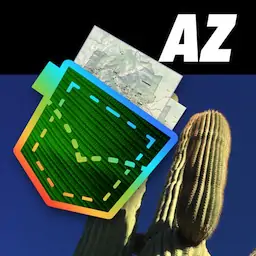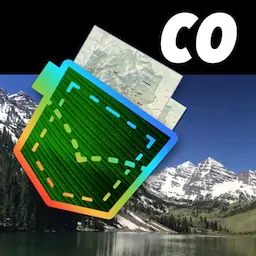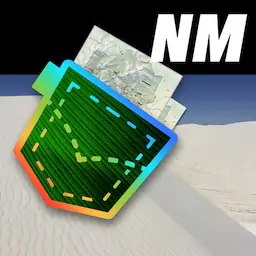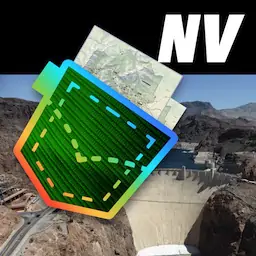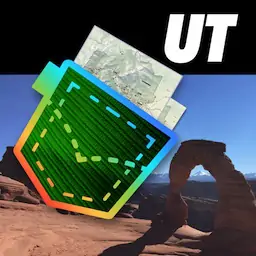"Virgin River Canyon, Arizona" by NPS , public domain
BrochureOld Spanish |
Brochure of Old Spanish National Historic Trail (NHT). Published by the National Park Service (NPS).
featured in
| National Parks Pocket Maps |  | |
| Arizona Pocket Maps |  | |
| California Pocket Maps |  | |
| Colorado Pocket Maps |  | |
| New Mexico Pocket Maps |  | |
| Nevada Pocket Maps |  | |
| Utah Pocket Maps |  |
During the winter of 1829-1830, Antonio Armijo led
a caravan of 60 men and 100 pack mules from New
Mexico to Mission San Gabriel in California, east of
Los Angeles. The caravan carried woolen rugs and
blankets produced in New Mexico to trade for horses
and mules.
Other trade parties soon followed. Some found
alternative routes that together became known as
the Old Spanish Trail. It took Armijo’s group about 12
weeks to reach California and six weeks to return on
the trail historians LeRoy and Ann Hafen called, “the
longest, crookedest, most arduous pack mule route in
the history of America.”
The lands crossed by the Old Spanish Trail were
alluring. For decades missionaries, fur trappers,
American Indians, and others ventured repeatedly
into and across the vast territory between New
Mexico and California.
By the time Armijo started his trip, New Mexican
traders were familiar with the routes others had
followed and utilized the cumulative geographic
knowledge gained from previous expeditions.
The trips were arduous. Dramatically changing terrain
and climate posed major challenges. Caravans lost
their way, suffered from thirst, and were forced to
eat some of their pack mules when supplies ran out.
Animals also suffered in the harsh desert environment
and endured severe weather.
View of Santa Fe in 1846 by John W. Abert
Commerce along the Old Spanish Trail began
as a legitimate barter for horses and mules, but
some traders and adventurers found it easier to
steal livestock than to obtain it legally. Americans
claiming to be beaver trappers, fugitive Indians
from the missions, gentile Indians from the frontier,
and renegade New Mexicans teamed together to
gather horses and mules to take illegally back to
New Mexico. In reaction to these widespread raids,
California authorities tried to recapture the stock and
punish the thieves but were never able to control the
illicit trade.
The line of march of this strange cavalcade occupied
an extent of more than a mile...Near this motley
crowd we sojourned for one night...Their pack-saddles
and bales had been taken off and carefully piled, so
as not only to protect them from damp, but to form
a sort of barricade or fort for their owner. From
one side to the other of these little corrals of goods
a Mexican blanket was stretched, under which the
trader lay smoking his cigarrito…
Along the Old Spanish Trail sound animals, good packing
equipment, and a capable crew were the prerequisites of a
successful pack train. The success of the trip depended on
the skills and abilities of those who packed and drove the
animals that carried the merchandise.
New Mexicans had a well-deserved reputation as excellent
horsemen and muleteers. American eyewitnesses marveled
at the dexterity and skill with which they harnessed and
adjusted packs of merchandise. Experienced travelers
suggested that New Mexicans should always be used as
teamsters for they “can catch up and roll up in half the time
the average person does.”
Packers were always in demand and utilized a variety
of skills. They secured loads with intricate knots, splices
and hitches; they acted as veterinarians and blacksmiths.
They estimated the safe carrying capacity of a mule, and
identified and treated animals suffering from improperly
balanced loads. They timed the travel day to stop at a
meadow or creek bottom that provided good forage.
Packers also had to be able to lift heavy loads, be good
farriers, and “accomplish marvels with the axe and screw
key and a young sapling for a lever.”
Beasts of Burden
Mules had incredible strength and endurance,
fared better than horses where water was
scarce and forage poor, and recovered more
rapidly after periods of hardship. Their hard and
small hoofs withstood the shock and abrasion
of rocky, boulder-strewn terrain.
Red Pass, California
Detail, San Gabriel Mission, 1832, by Ferdinand Deppe
Courtesy Sánta Barbara Mission Archive - Library
Courtesy Palace of the Governors Photo Archives (NMHM/DCA), 155329
Witness
Courtesy Laws Railroad Museum
Ben Wittick, Palace of the Governors
Photo Archives (NMHM/DCA), 015870
By this time Santa Fe is witnessing increased
economic activity brought on by successful
American and Mexican trade. Large quantities of
manufactured products arrive in New Mexico from
the eastern United States along the Santa Fe Trail.
Many goods are also traveling along El Camino
Real de Tierra Adentro to and from the interior
of Mexico.
In 1829, La Villa Real de Santa Fe de San Francisco
de Asis, provincial capital of New Mexico, was just a
dusty frontier town that sheltered a mix of Spanish
colonial families, newer Mexican arrivals, displaced
Indians, and a small, but growing number of
Americans. Over 1,000 miles to the west, the Pueblo
de la Reina de los Angeles was an even smaller ranch
town. Consisting of little more than a church and
plaza, and a few homes and government buildings,
it was the largest Mexican community in an area
characterized by dispersed ranches, decaying Spanish
missions, and Indian villages.
Packing the Train
Jeanne Howerton
Bureau of Land Management
National Park Service
It is 1829, eight years after Mexico gained
independence from Spain. New Mexican traders
travel overland to establish new commercial
relations with frontier settlements in California.
They carry locally produced merchandise to
exchange for mules and horses. Items include
serapes, blankets, ponchos, and socks; a variety of
hides – gamuzas (chamois), buffalo robes, bear and
beaver skins; as well as hats, shawls, and quilts.
Mules and Men
Lieutenant George Brewerton, 1848
Official Map and Guide
Old Spanish Trail
Old Spanish National Historic Trail
New Mexico, Arizona, Colorado,
Utah, Nevada, California
...the longest,
crookedest, most
arduous pack mule
route in the
history of America...
Connecting Two Mexican Provinces
The Equipment
Illegal Captivity
The Railroad and the End of the Trail
While the mule was the heart of the
transportation system, the packing
equipment played an equally significant role.
The aparejo (packsaddle) was the central
piece of gear and carried heavy, odd-sized
items safely over long distances without
injuring the animal. It was described by
one observer as “nearer to what I consider
perfection in a pack saddle, than any other
form of pack saddle yet invented.”
Long before traders ventured into this region,
American Indians traveled and traded along many
of the paths that the trade caravans later followed.
Petroglyphs show us that the mule caravans were
witnessed by American Indians along the route.
Indian guides had lengthy contact with Mexican
and American traders.
Beginning in the mid-1840s, new routes such as
wagon roads carried troops fighting in the MexicanAmerican War, pioneers bound for California, miners
joining the gold rush, and still more traders into the
West. A few notable Americans used the trail. In
1847 and 1848, Kit Carson carried military dispatches
east along the Old Spanish Trail. Military attaché
George Brewerton kept a detailed account of his trip.
John C. Frémont led U.S. government-sponsored
exploratory survey trips to plan for the advent of
railroads in the West.
Trade sometimes involved the illegal exchange
of horses, mules, and even human beings. Some
captives, including American Indians, Spaniards,
and Mexicans were ransomed at the frequent
trade fairs that characterized the western economy.
The slave trade changed the lifeways of American
Indians through depopulation and loss of traditional
knowledge. Human captivity was part of the reality
of the West, affecting all who lived in the region.
By 1869, however, a rail route connected the plains
of the Midwest and San Francisco Bay. Portions
of the Old Spanish Trail evolved into wagon roads
for local travel, but the days of cross-country mule
caravans on the Old Spanish Trail had ended.
Red Rock Canyon National Conservation Area, Nevada
Salt Lake City
t R er
iv
1846…… The Mexican-American War begins.
Abiquiu
Santa Fe
Los Angeles
NEW MEXICO
San Gabriel
North
0
10
20
30 40
50
100
SCALE IN MILES
Earlier explorations provided essential knowledge about the lands and cultures between Santa Fe and Los Angeles.
As trading opportunities opened up, traders sought the quickest and safest route.
1848…… Treaty of Guadalupe-Hidalgo ends MexicanAmerican War; the Southwest becomes U.S.
territory; California Gold Rush begins
i v er
n Pi
tch
Was
Los Angeles
215
Ri
Juan
ow
Me
ad
V
San Bernardino
n
ey
r
ve
Searchlight
Rive
5
1849…… Commercial caravans across the Old Spanish
Trail largely cease as more direct transportation
routes develop
2002…… The Old Spanish National Historic Trail is
designated by Congress
l ora
do
40
Barstow
Sa
•
•
Taos
de
Ver Riv
er
ARIZONA
•
•
San Luis
The Mojave Road:
A 188-mile crossing of the Mojave Desert long
used by area Indians and by Spanish explorers
and missionaries, it was first traveled by Jedediah
Smith, an American trapper, in 1826.
17
The Armijo Route:
The first complete trip across the trail began in
Abiquiú, northwest of Santa Fe. The Armijo partyArroyo C
h
followed well-known trails northwest to the San
Juan River, then nearly due west to the Virgin
River. They used the Crossing of the Fathers,
cut into rock canyon wall some 75 years earlier
by the Domínguez-Escalante party. Armijo’s
caravan went down the Muddy River and across
the Mojave Desert to the Amargosa and Mojave
Rivers, through Cajon Pass and down to Mission
San Gabriel.
25
Abiquiu
Santa Fe
ARIZONA
r
Pecos
To Franklin,
R ive Missouri
via the Santa Fe Trail
800 mi 1287 km
r
Taos
1844…… Francisco Rael carries domestic manufactures and
sheep worth $1,748.
CALIFORNIA
15
l ora do Rive
r
CALIFORNIA
r
n R i ve
Ker
Tecopa
Teec Nos Pos
er
Riv
r
Rive
o
1843…… Juan Arce hauls merchandise worth $487.50.
Traders used different routes from trip to trip,
depending on weather and water. Caravans
left New Mexico in the late summer or fall and
returned from California in the spring. Early
winter snows blocked mountain passes and
travelers chose their routes accordingly. In the
spring, traders worried about late snows and
floods. On every trip, they worried about water
and forage, often racing to beat other caravans to
known sources.
Kayenta
La Plata
Aztec
Arizona:
ico
NEVADA
Page
Mesquite
Las Vegas
Durango
R i v er
Rive
r
River
Armijo Route, 1829
North Branch, 1848
San Juan
irgin River
do
lora
Co
n
The following sites along the trail offer the
opportunity to experience some of the natural
landscapes crossed by the trail. They are only a
small sampling of places you can visit associated
with the trail. You can learn more by visiting the
official trail websites.
Gunnison
ver
Rio Grande
er
Mojave Road, 1826
The Old Spanish Trail’s rugged terrain discouraged
the use of wagons. It was always a pack route,
mainly used by men and mules.
Gun
ni
so
COLORADO
C
Littl e
1842…… A party of 40 New Mexicans from Abiquiú settles
at Agua Mansa and Politana in California;
Francisco Estevan Vigil and 194 men are issued
passports carrying 4,150 California animals back
to New Mexico.
ont R i v er
UTAH
Enoch
o R iv
Colorad
UTAH
Do
lo
40
To Mexico City, Mexico
via El Camino Real
de Tierra Adentro
1242 mi 2000 km
Salt R
i ve
r
10
Gila River
Phoenix
an
adi
C an
Jedediah Smith, 1826-1827
Northern Route, 1831
em
Fredonia
Co
COLORADO
All routes came together at Fork of Roads,
east of present-day
Barstow in the Mojave
ive r
sR
desert, andng’then
crossed Cajon Pass between
the San Gabriel and San Bernadino Mountains
to Coastal California. After negotiating the
pass, traders had an easy two to three days
travel to the San Gabriel Mission and beyond to
Los Angeles.
It is difficult to see traces of the trail in the
modern landscape. Most of the routes of the
Old Spanish Trail have been reclaimed by nature
or changed by later use. However, some of the
landmarks that guided trail travelers can still be
seen today.
Denver
Grand Junction
Green River
70
h
iver
1841…… Francisco Estevan Vigil arrives at Los Angeles and
presents a passport and instructions describing
the duties and responsibilities of a commander of
a caravan.
Dominguez-Escalante, 1776-1777
Francisco Garces, 1774
1839…… José Antonio Salazar arrives in California at the
head of a group of 75 men; Francisco Quintana
carries domestic manufactures worth $78.25.
Salina
Moab
ll
Va
25
do R
lora
Co
NEVADA
Ri
1826…… Jeddediah S. Smith leads a small party of
fur trappers westward from Cache Valley, Utah.
1837…… José María Chávez and family settle in what became
known as the Chávez Ravine in Los Angeles.
The trails witnessed dramatic growth in use
after 1821, when a large and broad array of
merchandise came to New Mexico from the
Eastern United States and Europe. Merchants
took many of these products further into Mexico
along El Camino Real de Tierra Adentro.
ns R
O we
Exploring the Trail
1825…… Antoine Robidoux builds Fort Uncompahgre
(Fort Robidoux) near present-day Delta, Colorado,
where Indians and traders bargained for goods.
1834…… José Avieta and 125 men arrive at Los Angeles
carrying 1,645 serapes, 314 blankets, and other
woolen goods.
Mojave Road
R
er
Ri v
res
1774…… Father Francisco Hermenegildo Garcés sets out
from southern Arizona to explore a path to
the California missions. He follows the Mojave
River and reaches Mission San Gabriel.
1821…… Mexico gains independence from Spain.
1831…… William Wolfskill and George C. Yount blaze a
more northern route that ascends into central
Utah before heading southwest into California.
Northern Route
Armijo Route
Y
The North Branch:
This route followed
well-known trapper and trade routes north through
r
Rive
e
t
i
the Rio Grande
gorge
to Taos and into southern Colorado. It then went
h
W
west through Cochetopa Pass, largely open during the winter when
other passes were snowed in and up the Gunnison River valley, rejoining
70
the Northern Route near present-day
Green River,
Utah.
iver
15
Fr
1765…… Juan María Antonio Rivera leads two parties
from New Mexico to explore southwestern
Colorado and southeastern Utah.
1781…… Spanish colonials establish El Pueblo de la
Reina de los Angeles in California.
1829…… Antonio Armijo leads the first trade caravan
from Abiquiú to Los Angeles, opening the Old
Spanish Trail.
North
Whi
te
1610…… Don Pedro de Peralta founds Santa Fe, the new
capital of New Mexico.
1776…… Franciscan priests, Francisco Atanasio
Domínguez and Francisco Silvestre Vélez de
Escalante follow Rivera’s route to the Great
Basin in western Utah.
North Branch
Ki
1598…… Don Juan de Oñate establishes San Juan de
los Caballeros (near modern Ohkay Owingeh
Pueblo), the first Spanish settlement in New Mexico.
Three trails, including the Old Spanish Trail,
merged in Santa Fe. El Camino Real de Tierra
Adentro (the Royal Road to the Interior Lands)
was a wagon road between Mexico City and
Santa Fe. The Santa Fe Trail, an international
wagon route that crossed the plains, linked
Missouri with Santa Fe.
Riv
er
TRAIL MILESTONES
Ree
se
EARLY EXPLORATIONS
ampa River
The Northern Route:
First blazed by William Wolfskill and George
C. Yount in 1831, this route veered northwest
from Abiquiú through Southern Colorado and
central Utah. It avoided the rugged canyons of
the Colorado River that the Armijo party had
encountered and took advantage of the better
water and pasture resources across central Utah
before returning to the Colorado River and
Armijo’s route not far from Las Vegas.
Old Spanish National Historic Trail
tt
R iver
Li
Green
ld
Sa
um
bo
25
Glen Canyon National Recreation Area
Grand Canyon/Parashant National
Monument
Navajo National Monument
Pipe Spring National Monument
•
•
•
•
•
•
•
•
Nevada:
•
•
•
•
•
•
•
•
•
•
•
•
•
•
•
Colorado:
•
•
•
Anasazi Heritage Center/Canyons of the
Ancients National Monument
Colorado National Monument
Curecanti National Recreation Area
Lake Mead National Recreation Area
Lost City Museum, Overton
Old Las Vegas Mormon Fort State Park
Red Rock Canyon National Conservation Area
Springs Preserve, Las Vegas
New Mexico:
California:
Desert Discovery Center, Barstow
El Pueblo de Los Angeles Historical
Monument
Mission San Gabriel, San Gabriel
Mojave National Preserve
Mojave River Valley Museum, Barstow
San Bernardino County Museum, Redlands
Dominguez-Escalante National Conservation
Area
Fort Garland Museum, Fort Garland
Fort Uncompaghre, Delta
Great Sand Dunes National Park & Preserve
Gunnison Gorge National Conservation Area
McInnis Canyons National Conservation Area
Southern Ute Cultural Center and Museum,
Ignacio
Ute Museum and Memorial Site, Montrose
Aztec Ruins National Monument
Palace of the Governors and New Mexico
History Museum, Santa Fe
Rio Grande Gorge Visitor Center, Taos
Spanish Colonial Art Museum, Santa Fe
Utah:
•
•
•
•
•
•
•
The Old Spanish National Historic Trail was
designated by Congress in 2002. The trail runs
through New Mexico, Colorado, Arizona, Utah,
Nevada and California. The Bureau of Land
Management and the National Park Service
administer the trail together to encourage
preservation and public use.
These two federal agencies work in close
partnership with the Old Spanish Trail
Association, American Indian tribes, state, county,
and municipal governmental agencies, private
landowners, nonprofit groups, and many others.
For more information, including more site
locations and trip planning tools, please visit
our official trail websites:
Bureau of Land Management
Utah State Office
www.blm.gov/ut
National Park Service
National Trails Intermountain Region
www.nps.gov/olsp
Volunteer Organization
Old Spanish Trail Association
www.oldspanishtrail.org
Arches National Park
Beaver Wash Dam National Conservation Area
Grand Staircase-Escalante National
Monument
John Wesley Powell River History Museum,
Green River
Museum of the San Rafael, Castle Dale
Dan O’Leary Museum, Moab
Iron Mission State Park, Cedar City
NEW MEXICO
5
15
NPS/BLM 05/12

